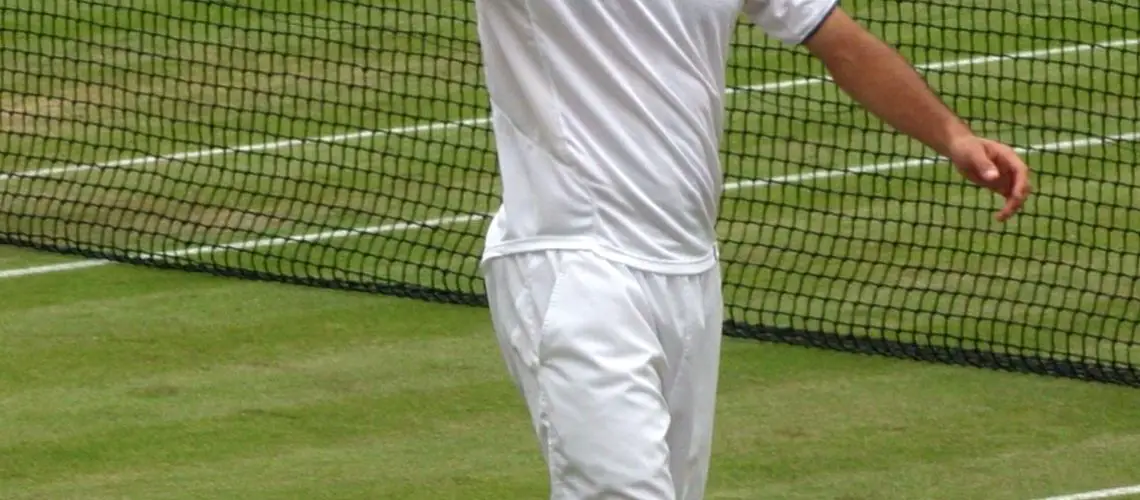We may earn money or products from the companies mentioned in this post.
A Quick Summary

Tennis is a popular sport with many rules and terminologies that can be confusing for beginners. The concept of a “let” is one such term, which occurs when a serve hits the net but lands within the service box without touching any part of the receiving player’s body or racket. Officials play a crucial role in enforcing the rules of the game, and technology such as Hawk-Eye can be used to help ensure accuracy in determining calls. There is debate over how much reliance should be placed on technology versus human judgment, as too much reliance on technology can reduce an official’s authority over a match.
Tennis Rules and Terminology: Understanding the Concept of a “Let”

Overview of Tennis
Tennis is a popular racquet sport played on a rectangular court, with two or four players hitting a ball back and forth over a net The objective of the game is to hit the ball in such a way that the opponent is unable to return it within the boundaries of the court Each player has one or two chances (depending on singles or doubles play) to hit the ball before it bounces twice on their side of the court
While tennis may seem like a simple sport, there are many rules and terminologies that can be confusing for beginners It’s important to understand these terms so that you can fully enjoy watching and playing this exciting game
The Concept of a “Let” in Tennis
One such term in tennis is the concept of a “let”. A let occurs when a serve hits the net but lands within the service box without touching any part of the receiving player’s body or racket In this case, instead of being counted as a fault, the serve is replayed without penalty
The importance of understanding this rule lies in its impact on gameplay If you are serving and your shot hits the net but lands in-bounds, you have another chance to make an effective serve Conversely, if you’re returning your opponent’s serve and it hits the net but still lands within bounds without touching your racket or body, then they get another chance to make an effective serve as well
Additionally, understanding what constitutes as a let can help prevent disputes between players during matches By knowing when to replay serves and when not to, players can avoid unnecessary arguments and keep games running smoothly
In Conclusion
Overall, understanding the rules and terminology of tennis, including the concept of a “let,” is crucial for both beginners and experienced players By doing so, you can fully enjoy the game and avoid disputes that may arise due to misunderstandings So the next time you watch or play a match, keep in mind these important aspects of tennis
| Key Point | Description |
|---|---|
| 1 | Understanding rules and terminology is crucial |
| 2 | Avoid disputes during matches |
| 3 | Enhance enjoyment of the game for all participants |
Definition and Explanation of a Let in Tennis

Circumstances under which a let is called
A let is a term used in tennis to denote an interruption of play due to certain circumstances There are two types of lets in tennis – service-related lets and non-service-related lets
1 Service-related lets
Service-related lets occur during a serve There are two main circumstances under which a let is called during the service:
a Ball touches the net but still lands in service box:
If the ball hits the net but still lands inside the designated service box, it is considered a let and the server gets another chance to serve
b Server not ready for opponent’s return:
If the server is not ready when their opponent returns the ball, they can call for a let, and replay that point
2 Non-service related lets
Non-service related lets can happen at any time during play, not just during service Here are some examples of circumstances that can lead to non-service related lets:
a External disturbances:
If there is an external disturbance on or around the court, such as stray balls or animals running onto the court, players may call for a let
b Player injury or equipment malfunction:
If any player suffers from injury or has equipment malfunction during play, they may also call for a let
In conclusion, while tennis players strive to maintain flow and continuity throughout play, certain circumstances may arise that necessitate calling for a let Knowing when to call for one and what constitutes as legitimate grounds for it can impact both gameplay and players’ safety on the court
| Key Point | Description |
|---|---|
| 1. Flow and continuity | Tennis players strive to maintain flow and continuity during play. |
| 2. Legitimate grounds for let | Knowing when and under what circumstances a let can be called is important. |
| 3. Impact on gameplay | Calling for a let can impact both gameplay and player safety on the court. |
Differences Between Lets and Other Tennis Rules

When it comes to tennis, there are several rules that govern the way players serve and play the ball One of these rules is the concept of “lets,” which refers to a situation where a served ball touches the net but still lands within the correct service box Compared to other tennis rules, such as faults, double faults, and foot faults, lets have distinct differences
Comparison with Faults, Double Faults, and Foot Faults
Faults occur when a player’s serve does not land in the correct service box or violates other serving rules This can include serving out of bounds or hitting the net with their serve On the other hand, double faults happen when a player fails to successfully serve twice in a row – essentially losing two points in one go
Foot faults are another type of error that can occur during serving They happen when the server touches or crosses over the baseline before making contact with the ball
In comparison to these types of errors during serving, lets occur when a served ball touches the net but still lands within the correct service box In this case, players can redo their serves without penalty
How Lets Differ from Unforced Errors and Forced Errors
Apart from errors that can occur during serving like faults or foot-faults; unforced errors and forced errors are also common occurrences in tennis gameplay
Unforced errors refer to mistakes made by a player during play that are not directly caused by their opponent’s actions This could be something like hitting an easy shot into the net or sending a shot wide of its target
Forced errors are different as they occur when an opponent puts pressure on a player leading them to make a mistake For example, if your opponent hits an aggressive forehand return forcing you into making an error on your next shot
In contrast to these types of errors which occur during regular play, lets are unique as they refer specifically to a situation during serving They allow players to redo their serves without penalty if the ball touches the net but still lands within the correct service box
Overall, while tennis may seem straightforward, there are many rules and nuances that govern how the game is played at a competitive level Understanding the differences between faults, double faults, foot faults, unforced errors, forced errors, and lets can help players improve their gameplay and increase their chances of success on the court
| Rule/Concept | Occurrence | Outcome |
|---|---|---|
| Faults | Serve does not land in correct service box | Loss of serve, second chance only |
| Unforced Errors | Mistake made by player without opponent’s influence | Point lost |
| Lets | Served ball touches net but lands within service box | No penalty, player allowed to redo the serve |
The Role of Tennis Officials in Enforcing Lets

Responsibilities of Chair Umpires, Line Judges, and Ball Kids
In tennis, officials play a crucial role in ensuring fair play and enforcing the rules of the game The chair umpire is responsible for overseeing the match and making final decisions on disputed calls They are also responsible for calling out when a serve is a let Line judges, on the other hand, are positioned around the court to determine whether a ball is in or out Finally, ball kids are responsible for retrieving balls that have gone out of play and returning them to players
The responsibilities of these officials may seem simple enough, but they require intense concentration and quick decision-making skills In addition to their primary duties, they must also be vigilant for any potential violations of the rules such as foot faults or coaching from players’ boxes
Use of Technology in Determining Calls (eg, Hawk-Eye)
While officials do their best to make accurate calls during matches, human error can sometimes come into play To help ensure fairness and accuracy in determining calls, technology has been introduced into professional tennis
One such example is Hawk-Eye technology which uses cameras placed strategically around the court to track the trajectory of a ball This allows for more accurate determinations on whether a ball landed inside or outside the lines Players can challenge calls made by officials by requesting a review using Hawk-Eye technology
Other technological innovations include electronic line-calling systems which use sensors to detect where a ball has landed on the court with high precision
Despite these advances in technology, there is still some debate over how much reliance should be placed on it versus human judgment by officials Some argue that relying too heavily on technology takes away from the human element of officiating and reduces an official’s authority over a match
Overall, tennis officials play a critical role in maintaining the integrity of the game and ensuring fair play While technology can aid in making accurate calls, it is important to strike a balance between human judgment and technological assistance
| Key Point | Explanation |
|---|---|
| Maintaining integrity | Tennis officials ensure fair play in the game |
| Balance with technology | Use of both human judgment and technological aid |
| Authority over a match | Officials’ authority should not be overly reduced |
Useful Links

Why do they say let in tennis?
Serve (tennis) – Wikipedia
What Is A Let In Tennis? Definition & Meaning On …
What is a Let in Tennis?
What Is a Let in Tennis: A Comprehensive Guide
What Is A Let Ball And Net Ball In Tennis
Let & Net In Tennis: What Does It Mean?
What is a Let in Tennis – How Many Can Occur During …
What is a Let in Tennis
How Many Let Serves Are Allowed In Tennis? My Helpful …
Breaking the Rules: letting go of the let serve
What Is a Let in Tennis? – Tennis Rules
How Many Lets Are Allowed In Tennis? – The Racket Life
What Does LET Mean In Tennis? 2 Rules On Calling A Let
What Is a Let in Tennis
Rules of Platform Tennis
what is a Let Rule in Tennis: A Comprehensive Guide …
Rules of Tennis | Wanless Park Tennis






